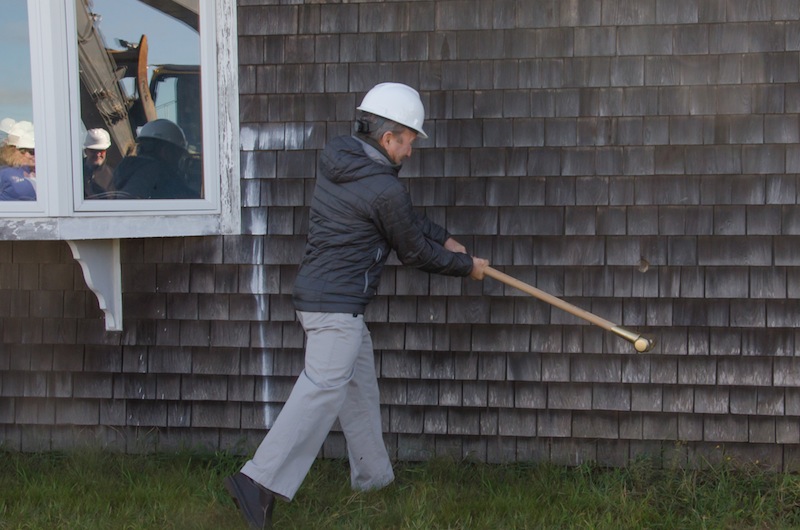Swinging gold sledge hammers, members of the Martha’s Vineyard Airport Commission took a symbolic whack at the airport rescue and fire fighting building Friday morning, marking the beginning of construction to replace the old structure.
A few moments later, an excavator moved in to start the job in earnest. The demolition makes way for a new building that will house fire trucks and snow removal equipment, offices, and staff quarters.

Commission vice-chairman Robert Rosenbaum said when he was appointed in 2015, he was “horrified” at the status of the project four years after the Federal Aviation Administration awarded a grant to replace the building.
“It was 30 per cent complete and the cost was twice the allotted budget,” Mr. Rosenbaum recalled. He said FAA administrators were also angry when they learned the status. “The project was within a hair’s breadth of being cancelled entirely.”
The project is now back on track, with a project cost of $10.5 million. The FAA has committed $7.4 million for the building, which is required under federal law.
The airport has set aside $1.6 million of its own funds for design and construction, and is working to find state or other sources of funding for the remaining $1.5 million to complete the project.
The new building is scheduled to be reviewed next month by the Martha’s Vineyard Commission as a development of regional impact.
The Island’s only commercial airport is expecting modest growth in the coming years, according to an airport master plan discussed at the commission’s monthly meeting on Thursday. Members reviewed a summary of the plan, which includes growth projections, capital improvements, and an extensive assessment of airport buildings and equipment.
Projections call for an increase of about 2,000 airport operations (defined as a landing or takeoff) by 2034. In 2014, the airport recorded approximately 42,000 operations.
The number of aircraft based at the airport is expected to increase from 77 in 2014 to 112 in 2034.
The airport master plant conflicts with FAA projections, which predict no substantial growth over the next 20 years, according to the consultant who presented the plan summary.
The plan lists capital improvements at a cost of $27.1 million over the next 18 years. The commission expects $24.8 million of that cost to be funded by the FAA, with $1.4 million contributed by the airport, and the rest from state funds and other sources.
Among the projects slated for 2017 are painting new taxiway lines and reconstructing runway shoulders. In 2018, the runways are slated for reconstruction and repaving.
Some of the projects may not be funded as needs evolve over the next two decades, but they must be listed in the master plan in order to be eligible for FAA grants, according to airport manager Ann Crook.








Comments
Comment policy »